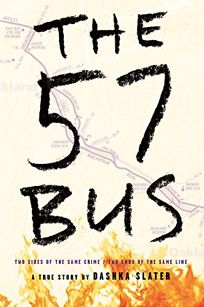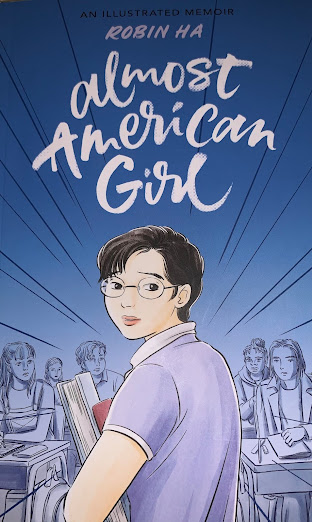The 57 Bus
Written by: Dashka
Slater
Project Created by: Mark Bibian, Sarah Bidgoli, Sara Brune & Nataly Casillas
Project Created by: Mark Bibian, Sarah Bidgoli, Sara Brune & Nataly Casillas
Review:
Richard and Sasha had always taken the same bus and had crossed paths on multiple occasions. On this particular day, Richard saw Sasha in their skirt and decided to set it on fire as a small practical joke.
 |
| The Oakland High School Wellness Center's support of "NoH8" |
Sasha is a white, middle-class teenager who attended a small private school. Richard, on the other hand, is an African-American, who attended a large public school. While it would seem like a no-brainer that Richard committed a serious crime and should be punished, Slater takes a different approach and gives readers both sides of this incredible story making this a not so simple situation. Readers get a personal look at the daily struggles members of the LQBTQ community face on a regular basis. Simultaneously, we get the other side of story, in which readers see that Richard was viewed as a young man who had potential to do good things with his life. We recognize that Richard, and many like him, commit harmful acts based on youthful ignorance.
The novel is excellent for young readers to learn not to be quick in judging others without looking at all factors of the crime committed and at the person who committed it. While no offense should go unpunished, Slater attempts to give readers a better understanding of why Richard did what he did and how he felt after he realized the implications of his actions. Providing readers with both sides of the story allows readers to have empathy for both the victim and the criminal.
 |
| People showing support for Sasha after the incident |
Biography:
 |
| Dashka Slater |
Works Referenced:
Amazon Reviews
American Library Association news
Kurkus Magazine
National Endowment for the Arts: Writers' Corner
American Library Association news
Kurkus Magazine
National Endowment for the Arts: Writers' Corner
Resources:
1. Burke, Brianna R.Greenfield. “Challenging Heteronormativity: Raising LGBTQ Awareness in a High School English Language Arts Classroom.” English Journal, vol. 105, no. 6, 2016, pp. 46–51.
Burke deals with the concept of how many high school
students remain silent when they cannot see their identity represented in their
school curricula. One of the strongest arguments of this source is how we as educators must
promote inclusivity within the subject material, classroom and school
environment. Burke explains how if we ignore the problem of discrimination, we
are depriving students of the truth, and a remedy to solve it or become aware
and not continue the cycle. This article provides steps educators can take
before, during and after a lesson on sexual identity. It offers options such as
talking to the principal, sending letters home justifying lesson, allowing
students to opt out of lesson, fostering critical thinking and also allowing
students to share their thoughts.
2. Batchelor, Katherine E., et al. “Opening Doors: Teaching LGBTQ-Themed Young Adult Literature for an Inclusive Curriculum.” Clearing House: A Journal of Educational Strategies, Issues and Ideas, vol. 91, no. 1, 2018, pp. 29–36.
2. Batchelor, Katherine E., et al. “Opening Doors: Teaching LGBTQ-Themed Young Adult Literature for an Inclusive Curriculum.” Clearing House: A Journal of Educational Strategies, Issues and Ideas, vol. 91, no. 1, 2018, pp. 29–36.
Katherine Batchelor explains how unsafe
school environments can affect factors such as psychological and academic
levels in LGBTQ students. Some of the solutions to creating a safe school
environment provided are incorporating LGBTQ themed literature, creating a
supportive classroom, and treating all voices as equal. Yet, in order to be
able to incorporate those subjects into the classroom, the article states that
educators need to educate themselves on it first, as teachers need to know how
to handle topics of controversy and nondominant viewpoints. A section of this
article was focused on how LGBTQ literature can allow for students to create
concepts such as their identity formation, and as a ‘window’ which allows for
an open dialogue in the classroom. This is a good article to present to
educators and parents who do not see the importance of having an all inclusive
curriculum in the classroom setting.
3. "The Fire on The 57th Bus in Oakland" New York Times, 2015.
 |
| Sasha featured in the New York Times |
 |
| Richard and his younger brother also featured in the New York Times |
4. San Francisco Bay Transit
This is an active map of Oakland and the route that the 57 bus actually takes.
The stops are all highlighted in blue, and shows where the incident occurred.
This map gives context to students about where the burning took place and how
little Richard and Sasha really saw of eachother. This could be used to also
begin an activity for plotting the locations of where the events took place.
This map allows the user to zoom in and out and to get a satellite view of the
route and surrounding areas. This allows the user to get context about the
location, the arrival and running times, and the distance between each stop on
the route. This gives context to the amount of time Shasha and Richard were on
the bus that day and how far each of them were to their homes.
5. Juzwik, Mary, et al. “Struggling to Belong: Literacy
Instruction, Coaching, Learning, and Development.” Research in the Teaching
of English, vol. 52, no. 3, 2018, pp. 229–235.
The article discusses racism in the classroom and how
anything from a microaggression to systematic and institutional oppression
works to disadvantage students of color. This relates to the novel as we see
how the school systems and communities set up to “help” have failed Richard.
6. Dyson, Anne. “A Sense of Belonging: Writing (Righting)
Inclusion and Equity in a Child's Transition to School.” Research in the
Teaching of English, vol. 52, no. 3, 2018, pp. 236–261.
This article also discusses race but focuses on the
importance of equity and inclusion in the classroom. Students need to
represented in order to feel important. Representation also lends itself to
debunking stereotypes and bridges gaps between cultures. This relates to the
novel as Richard sets Sasha aflame because they were different but if he was
taught about LGBTQ+ cultures, he might have acted differently.
7. Video: "Every Sex & Gender Term Explained," Science Plus. Youtube, 2015.
7. Video: "Every Sex & Gender Term Explained," Science Plus. Youtube, 2015.
This YouTube Video is called “Gender Identity: Sex and
Gender Identity” posted by Science Plus. The video breaks down the different
types of gender and sexes that can often be confusing. The novel uses a number
of different terms that can be overwhelming if a student is not familiar with
such terms. This video serves as a great introduction for the novel and will
give students a better background knowledge of sexes, genders, sexual
orientation, and personal pronouns.
8. Article: "This Book Will Challenge Everything You Thought You Knew About Hate Crimes," Mother Jones. 2017.
This article details the events as they happened the day of the incident in 2013. Mother Jones then conducts an interview with Dashka Slater on her writing, the fire, the agendered language that she employs in the novel, and more about the book to help readers earn about her take on the events. Slater discusses crime, hate, love, and community in this interview, which make it a great place to learn about the author behind and her motivations for writing the novel.
8. Article: "This Book Will Challenge Everything You Thought You Knew About Hate Crimes," Mother Jones. 2017.
 |
| Oakland High School shows support for Sasha |
Lesson Plan
Title: 57th Bus: An Exploration of Gender and Language PerspectiveGrade/Subject: 10th/English 2
Goal of the Lesson: To allow students to see the different perspectives, troubles, and ways in which language creates gaps in a person's identity.
 |
| Institute For Educational Advancement |
- RL.10.2 Determine a theme of central idea of a text and analyze in detail its development over the course of the text, including how it emerges and is shaped and refined by specific details; provide an objective summary of the text.
- RL.10.3. Analyze how complex characters (e.g. those with multiple or conflicting motivations) develop over the course of a text, interact with other characters, and advance the plot or develop the theme.
- RL.10.5. Analyze how an author's choices concerning how to structure a text, order events within it (e.g. parallel plots), and manipulate (e.g. pacing, flashbacks) create such effects of mystery tension, or surprise.
- RI.10.4. Determine the meaning of words and phrases as they are used in a text, including figurative, connotative and technical meanings; analyze the cumulative impact of specific word choices on meaning and tone.
- RI.10.6. Determine an author's point of view or purpose in a text and analyze how an author uses rhetoric to advance that point of view or purpose.
Narrative:
This lesson will take place after the class has completed the novel. Students will be asked to critically and consciously think about how language, perspective and society are factors that affect people differently. We will begin class by passing out a warm up assignment asking students to define some terms using their texts. They will have the option to either work alone or with a partner. This will act as an activity that will allow them to think about the terms while utilizing proper in text citations. After ten minutes have passed, students will be asked to share their definitions.
The class will then transition into a bigger activity where they will be asked to write within the two perspectives of Sasha and Richard. Students will have to take into consideration and respect the limitations and differences that each character has. This will showcase how society has different effects on different people going as far as affecting their identities. Students will then be asked to share their work with the class or a partner. The final assignment will be a quick reflection where students will be able to gather their thoughts about the way society works, how it affects different people and how language can create barriers. After ten minutes students will turn in their assignment for credit.
 |
| Odyssey |
Activities:
Our lesson will be sectioned into three different assignments:
 |
| The Well |
- Warm Up/Cornell Notes
- Paragraph Rewrites
- Reflection




